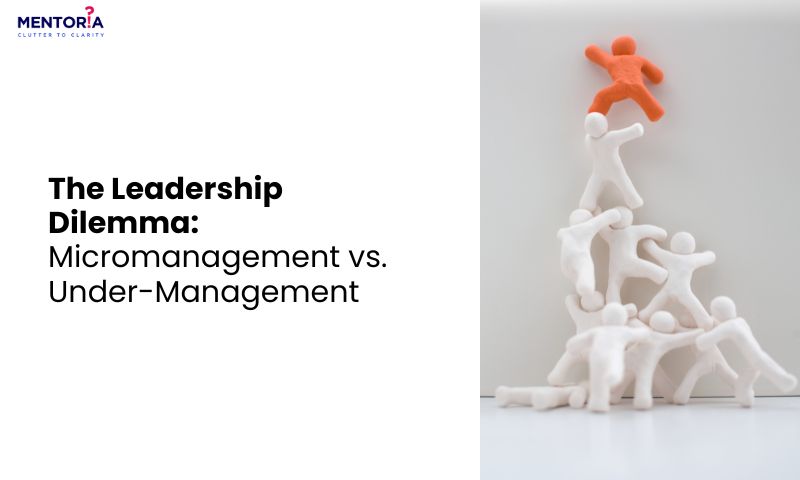The Leadership Dilemma: Micromanagement vs. Under-Management

Jump to Section
Managers who are convinced they don’t have time to manage almost always spend lots of time managing people anyway. That’s because whenever a manager avoids spending time up front making sure things go right, then things almost always go wrong. Small problems pile up and grow until they become so big that they cannot be ignored. By that point, the manager has no choice but to chase down the problems and solve them.
These managers run around solving problems that never had to happen, getting big problems under control that should have been solved easily, recouping squandered resources, dealing with long-standing performance problems, and feeling even more pressed for time. In all likelihood, they will go right back to managing on autopilot, and the next time they’ll make time for more engaged management is the next time there is another big problem to chase down and solve. Micromanagement gets down to the nitty-gritty of how and when tasks should be done. A good manager sets goals but doesn’t dive into the minute details of how employees reach those goals. For example, if you task your marketing director with boosting social media reach, you trust them to figure out the platforms and data aggregation methods. Even if they struggle initially, they might explore various avenues to make it work, understanding that results take time. The key for the manager isn’t immediate completion but seeing the effort and strategic approach taken. This is just one aspect of micromanaging employees.
As a manager, you need to find the right balance between being too involved and too detached from your team. Some managers avoid being seen as micro-managers by giving their team too much freedom. Others fear that their team will not perform well without constant guidance. Achieving the optimal level of management is crucial for the well-being and growth of a company.
How To Spot A Micromanager or an Under Manager In The Workplace
A manager’s job is to provide guidance and support. Their role is to facilitate a healthy environment where employees can perform at their best – reaching their potential by having true autonomy in their roles and building their confidence. Unfortunately micromanagers and Under managers achieve exactly the opposite.
Under-managers have poor performance management, avoid employee conflicts, and lack accountability. They barely give feedback on their employees’ work and do not keep up with the latest developments. If employees think that their supervisor does not care, they lose interest as well. The company’s culture and its ability to attract the best talent are harmed. This management style may seem smooth for a while – in fact, under-managers are often popular – but it also stops employees from having meaningful chances for growth. Micromanagers, on the other hand, are too involved in their employees’ daily tasks. They constantly monitor and interfere with team members and ask for updates on project progress. They may even enjoy making frequent corrections. Unlike under-managers, these bosses hardly give their employees any freedom. While their dedication to the organisation may be undeniable, their trust in their employees is very low. As a result, subordinates have no chance to figure things out or learn from their errors – which are essential and valuable learning moments.
Researchers from Southern Illinois University found that long-term micromanagement can have significant costs, including “low employee morale, high staff turnover, and reduction of productivity.”
Different Styles Of Job Duty Assignment
Micromanagement and under-management are two types of management approaches that can impact employee morale, productivity, and organisational success. Micromanagement involves excessively detailed and strictly controlled job duties, leaving little room for independent decision-making or creative problem-solving. This can lead to employees feeling disempowered, demotivated, and hindering professional growth. Under-management, on the other hand, involves vague or poorly communicated job duties, leading to confusion about priorities and objectives. This can result in inefficiency, missed deadlines, and lack of accountability.
A manager who undermanages usually does not change their job duties. For example, a relaxed manager in the marketing department normally does not interfere in matters that are outside of their department. However, a micromanager takes on extra job duties and crosses the boundaries of the organisation to manage other departments. For instance, a CEO who goes down to the receptionist’s desk to instruct them on how to greet customers is practising micromanagement.
To strike a balance, a well-managed scenario should involve clearly defined job duties, providing employees with autonomy and responsibility, regular check-ins, and guidance from managers. Employees should have a clear understanding of their tasks and responsibilities, while managers provide support, direction, and resources when needed. This fosters an environment of trust and empowerment, allowing employees to feel engaged, motivated, and capable of performing their duties effectively while still receiving necessary guidance and support from their managers.
Lack Of Trust Due To Micromanagement
Undermanagers promote a culture of autonomy and self-reliance in the workplace. Employees have the freedom to manage themselves and do not have trust issues. However, micromanagers often undermine the trust that managers have with their employees. For example, if a micromanager constantly tells a manager or employee how to do her job, the employee eventually feels that her judgement is not valued. This trust issue can lead to a loss of motivation and self-esteem in the office.
Undermanagers and micromanagers have different effects on the workplace culture and the employee behaviour. Undermanagers may foster a sense of independence and responsibility among the employees, but they may also neglect to provide adequate guidance and feedback. Micromanagers may ensure that the tasks are done according to their standards, but they may also stifle the creativity and initiative of the employees. Both styles of management can have negative consequences for the organisation’s performance and morale. Therefore, it is important for managers to find a balance between under managing and micromanaging their teams.
Communication
The level of communication from a micromanager and an undermanager is one of the main distinctions between the two management styles. Micromanagers often communicate their views, solutions and issues with other employees and managers frequently. Undermanagers are usually quiet and do not communicate with their employees. If an employee has a problem or concern, she usually cannot expect a lax manager to notice and take action. Employees have to initiate a conversation with an undermanager to get results.
Communication is a vital skill for any manager, as it affects the relationship between the manager and the employees, as well as the performance and morale of the team. Micromanagers may communicate too much, but in a way that is controlling, intrusive, and demotivating. Undermanagers may communicate too little, but in a way that is neglectful, distant, and confusing. Both styles of communication can have negative impacts on the organisation’s culture and productivity. Therefore, it is important for managers to find a balance between micromanaging and undermanaging their communication.
Contractors, previously silent about their challenges, have found a platform to voice their concerns using Facebook Workplace, the company’s internal communication system. These moderators, employed by Accenture on behalf of Facebook, are engaging in passionate discussions about various issues such as micromanagement, reduced pay, and insufficient counselling support. These concerns are particularly relevant as they navigate mentally demanding roles within Facebook. The messages on Workplace have garnered attention, with thousands of employees viewing or participating in these discussions, as per The Washington Post’s review of the conversations.
Chain of Command
The authority structure is often unclear when a micromanager interferes with the activities of other departments in the business. For instance, if the leader of a company starts to micromanage employees working on a marketing project, the employees might be unsure about who they should report to regarding the project. However, undermanagers are usually recognised as the “boss” – regardless of whether they take an active role in the business or not.
Micromanagers and undermanagers have different impacts on the organisational hierarchy and the employee roles. Micromanagers may create confusion and conflict among the employees and the managers of other departments, as they overstep their boundaries and undermine their authority. Undermanagers may create a lack of direction and guidance among the employees, as they fail to provide clear expectations and feedback. Both styles of management can have negative effects on the organisation’s efficiency and effectiveness. Therefore, it is important for managers to find a balance between micromanaging and undermanaging their teams.
Talk About the Outcome, Not the Process
When assigning tasks, it’s crucial to frame the process clearly and give people autonomy to step up and be leaders. Great managers allow people to experiment, make mistakes, learn, and grow, resulting in stronger performers. When assigning tasks, talk about the desired outcome, not every step. Brené Brown’s concept of “painting success” suggests discussing what “done” and “good job” look like to keep everyone on the same page. For example, if the goal is “D resolution,” start with a detailed problem analysis and ask team members how they would approach it. Even if you don’t agree with their proposal, it shows trust, interest in their ideas, and value for their contributions.
Setting expectations for feedback involves discussing the type of feedback you will share, whether it’s line-editing or directional feedback. It’s important to remain objective and check for micromanaging tendencies. For example, if you’re eager to line-edit, consider the audience and the purpose of the proposal. If the proposal is for an internal team meeting, don’t fix every sentence, but if it’s for the press or senior stakeholders, don’t overly detail. Feedback should match the consequences, and overly detailed feedback can make someone feel picked on, hindering their learning process.
Steps To Avoid Under-Management
Firstly, confront conflicts instead of dodging them. Managers often shy away from conflicts, but addressing them head-on is crucial. Identify the core issues, gather the involved parties, and outline a plan for resolution. If necessary, consider reassignment. With practise, conflict resolution becomes more manageable. Secondly, establish clear and attainable goals. Prioritise setting goals as they serve as the guiding map for management decisions. Ensure these objectives are both achievable and transparent; otherwise, your team won’t be able to meet them.
Lastly, foster accountability within your team. While being liked by subordinates is positive, accountability reigns supreme. Encourage accountability by prompting individuals to assess if they are delivering their best work. Encourage them to reflect on their performance levels. This self-reflection should extend to you as a manager as well.
How To Strike A Balance
Finding a balance between under- and micro-management strategies and habits is possible and can help you develop a management style that is suitable for your team and your business. If you usually avoid communicating with your team because you are afraid of creating conflict, one option is to arrange regular meetings with your employees. During those meetings, let them evaluate their own performance. You can then discuss any issues that they mention and work together to find solutions. Since you are asking your team for self-evaluation, you don’t have to feel as if you are causing trouble.
If you tend to micro-manage, it can be hard to step back and let your team work independently. One way to overcome the tendency to micromanage is to give your team a list of expectations, rather than a list of tasks. Let them know that they can complete the work as they wish, as long as it meets the expectations in the end. Depending on how much you hover or micro-manage, you might need to leave the area or room while your team works.
Balancing under and micro-management can benefit your team and your business in many ways. It can improve the trust and communication between you and your employees, as well as their motivation and creativity. It can also enhance the quality and efficiency of the work, as well as the satisfaction and retention of the employees. Therefore, it is important for managers to find the right level of management that works for them and their team.
Finding The Right Balance With Mentoria
By striking a balance between micromanagement and under-management, managers can create a work environment that is productive, engaging, and satisfying for all employees. This can lead to increased employee morale, motivation, and performance, as well as improved customer satisfaction, innovation, and profitability. Mentoria can help individuals and organisations manage workplace dynamics by providing a range of services and resources that promote career development, skill development, and workplace success. We also provide a variety of online resources, including articles, videos, and webinars, on career development and workplace dynamics. These online resources can help individuals learn about different career options, develop their skills, and navigate workplace challenges.









